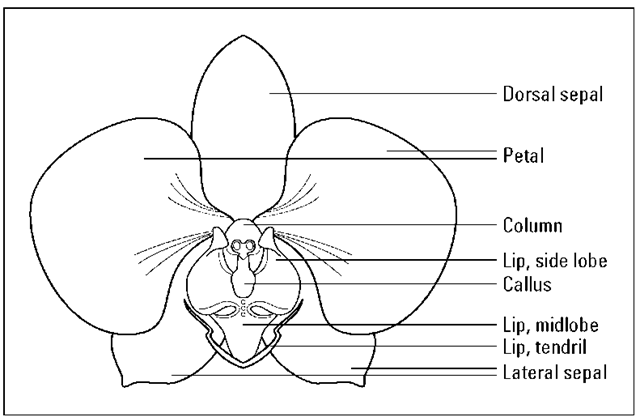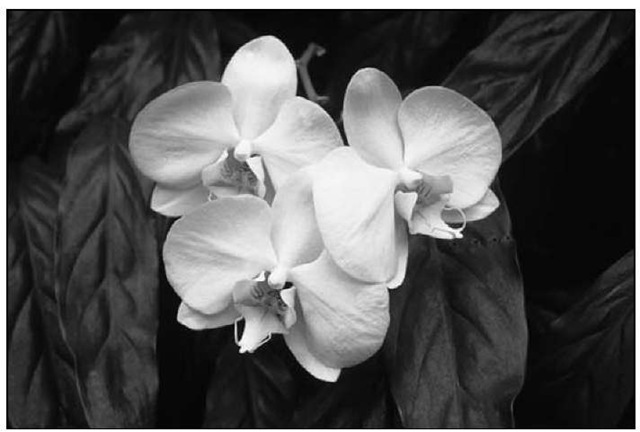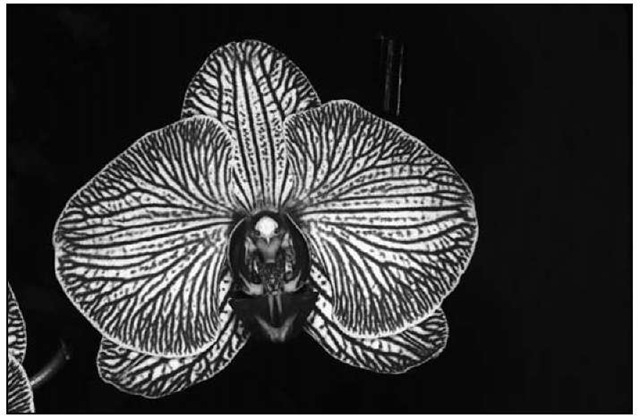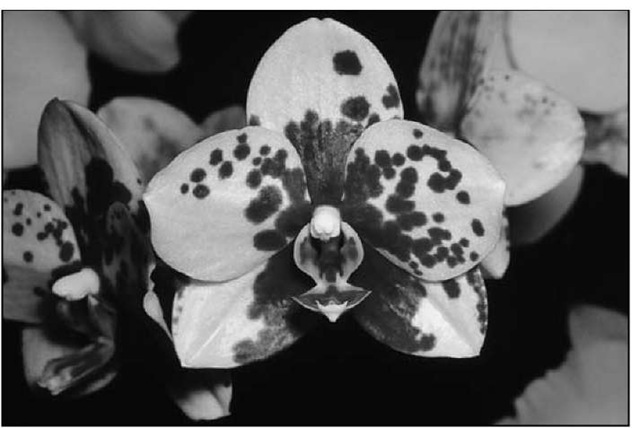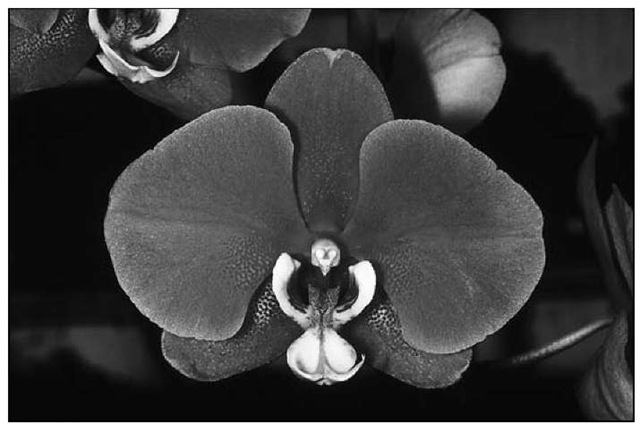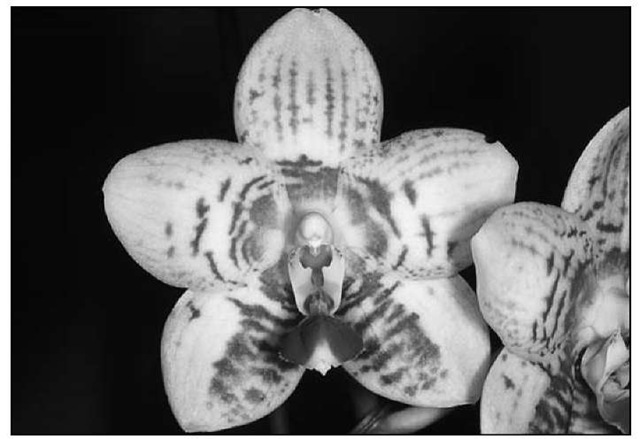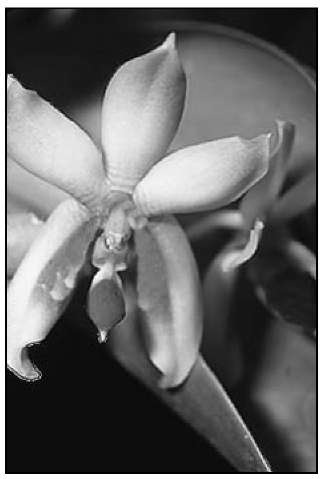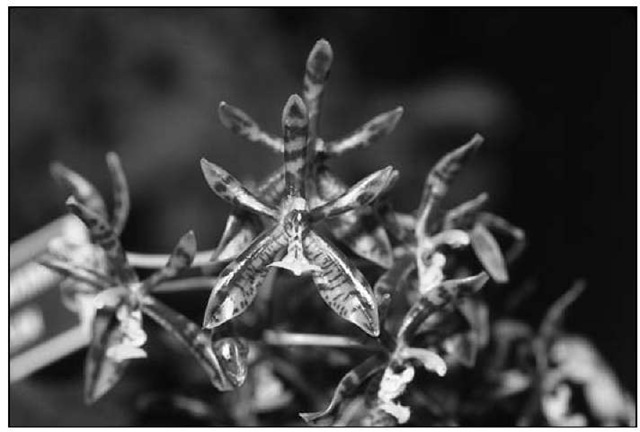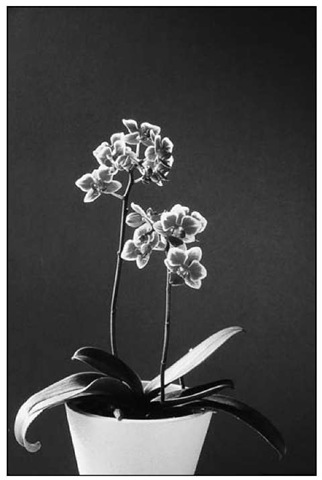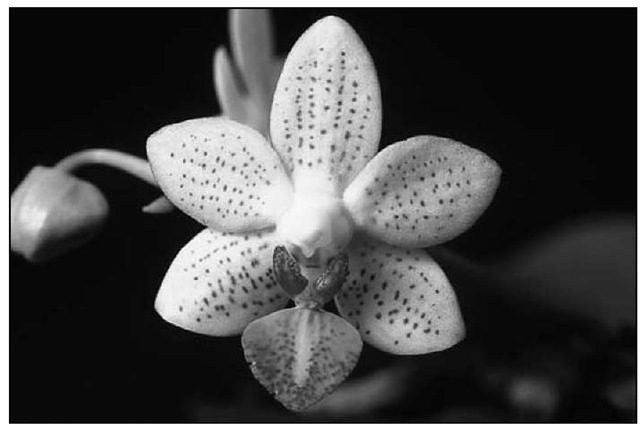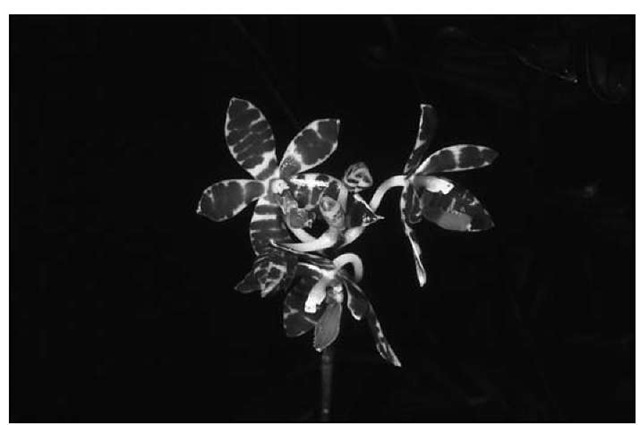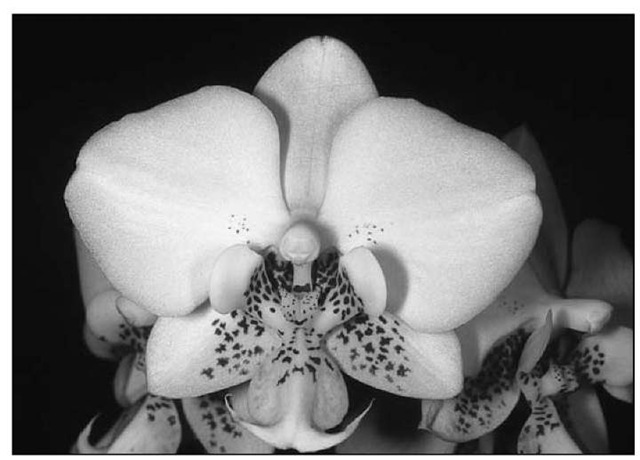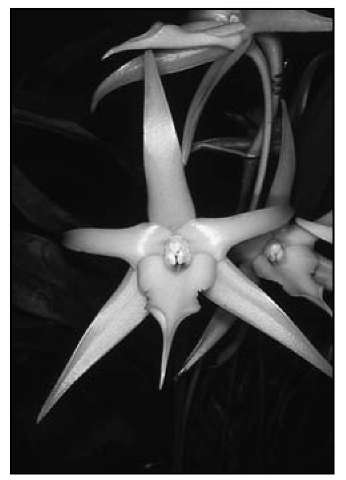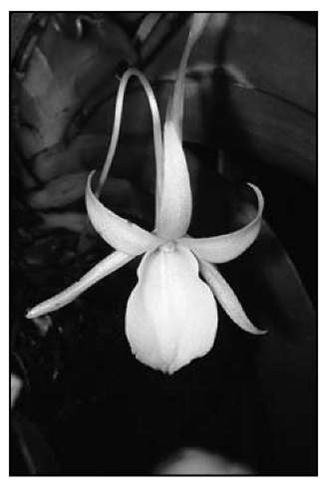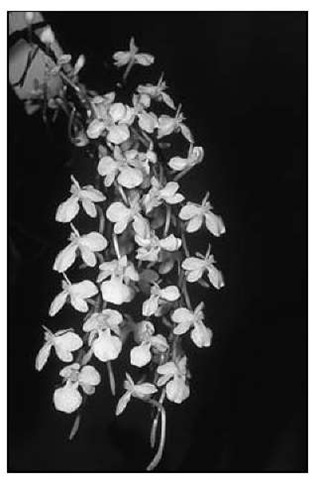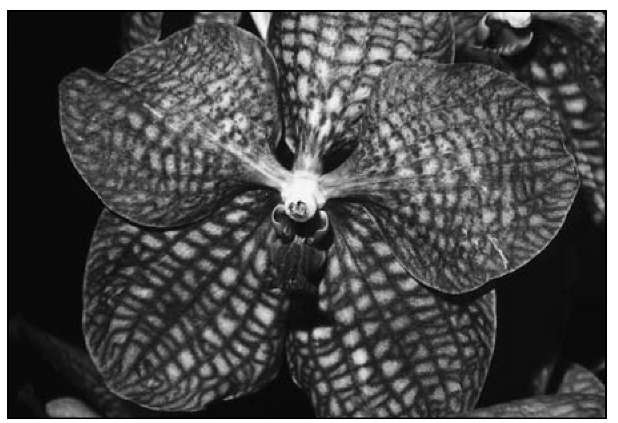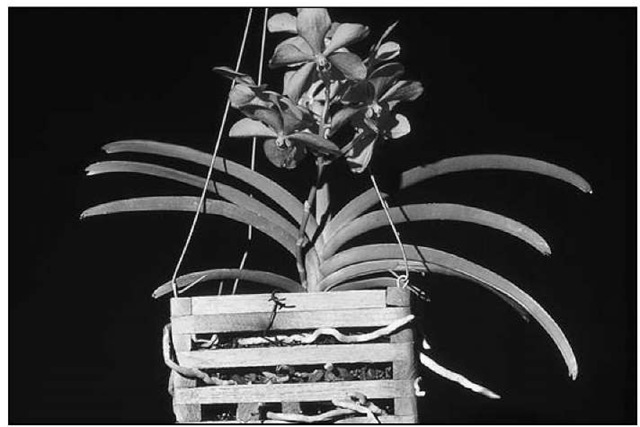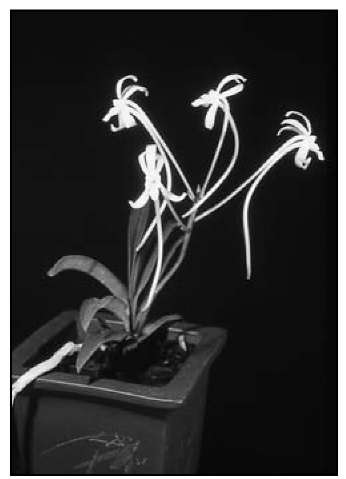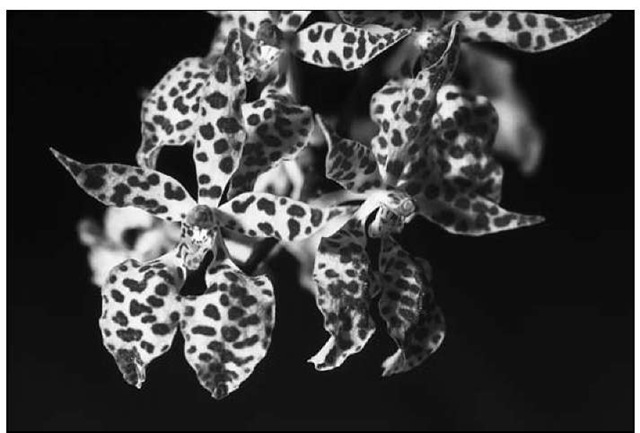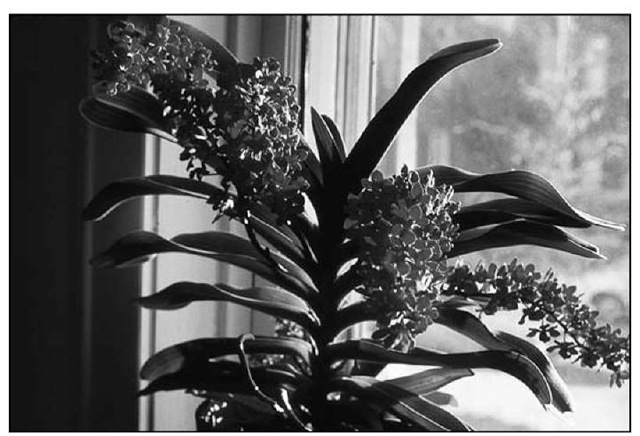In This Topic
- Finding perfect starter orchids
- Knowing the various types of moth orchids
- Looking at Africa’s gift to orchid lovers — the angraecoids
- Considering vandas and some other moth-orchid cousins
This type of orchid is the most popular grown today. In fact, according to the American Orchid Society, moth orchids account for 75 percent of all orchids sold!
Moth orchids (phalaenopsis) offer everything that most orchid growers admire and are the fastest and easiest to grow. They bloom for a long period of time — from many weeks to months. The flowers are classy and borne on elegant arched sprays. And moth orchids come in a broad range of colors. Their foliage is beautiful glossy green or marbled, they have very modest light requirements, and they grow well in temperatures commonly found in the home.
Moth orchids are definitely the orchids to start with, and after you experience the great satisfaction that they provide, you may decide to stay with them. The standard pink, white, and striped ones commonly sold in the box stores and at flower shops are the essence of style, but in addition to these beauties, there are many new and exciting colors, color patterns, and growth habits that even increase their desirability. Although most phalaenopsis are not fragrant, some are.
In this topic, I tell you all about moth orchids and their relatives.
Mirror, Mirror on the Wall: The Beauty of Moth Orchids
Moth orchids are beautiful plants, and in this section, I fill you in on exactly what to expect from yours.
Leaves
All the moth orchids have handsome foliage. Many of them have dark-green, leathery, glossy leaves, while others exhibit exquisitely marbled dark-green and gray-green leaves, so even when these plants aren’t in bloom, they remain quite attractive (see Figure 10-1).
Figure 10-1: A close-up of the beautifully patterned leaf of Phalaenopsis stuartiana.
Flower shapes
The various types of moth orchids have very similar shapes, though many of the newer varieties have a very rounded look. Figure 10-2 shows you the names of the parts of the moth orchid flowers. Because moth orchids epitomize style, they’re frequently used in flower arrangements and in simple, yet chic, corsages.
Figure 10-2: The parts of a moth orchid (phalaenopsis) flower.
Flower colors
White, pink, and candy-striped are the “standard” moth orchids that are most commonly found at flower shops and box stores as both potted plants and cut flowers for wedding bouquets (see Figure 10-3, Figure 10-4, and the color insert). These colors of moth orchids seem to have reached the pinnacle of perfection in flower size and shape and, because of modern reproduction and growing methods, they’re highly affordable. In fact, in Europe and certain large urban centers in the United States, they’re commonly purchased as an expendable blooming potted plant that is discarded after its many weeks of bloom.
Figure 10-3: Just about all white phalaenopsis available today display pristine, round, graceful flowers.
Figure 10-4: Candy-striped moth orchids present a striking picture. This one is called Phalaenopsis Jackie Debonis.
I don’t recommend any specific varieties within this group because there are so many. These types of phalaenopsis have been perfected to such a degree that just about all of them available these days would be ones you would be happy to give a home.
Due to the fine efforts of orchid hybridizers in the United States, Asia, and other parts of the world, we now have moth orchids with a huge variety of flower colors — from harlequins with random spotting patterns backed with yellow or white petals (see Figure 10-5) to dark purple, and rich pink with white lips (see Figure 10-6), clear yellows, greens, and burgundy reds,. About the only color that isn’t yet found in phalaenopsis is blue, and breeders are working diligently to add this color to the palate.
To intensify the markings on these orchids, try growing them in a little drier, cooler, and brighter location than usual when they’re starting to flower.
Figure 10-5: A harlequin-type of orchid, Phalaenopsis Sue Chin.
Figure 10-6: Phalaenopsis Hilo Lip is a dark cerise with a bright white lip.
Encore! Encore! A second show
One of the great features about moth orchids is their ability to produce a secondary flower spike that branches off the main one (as shown in the nearby figure). This will make your flower show go on for months!
To make this happen, after the flowers have stopped blooming on the flower spike, feel along this bare spike and notice the bumps along this stem. These knobby structures are called nodes. At the base of these nodes are resting flower buds. Your mission is to wake up one of these buds so it will produce another flower spike. Notice where the first flower opened on the stem, and go to the next node down, toward the base of the plant. This is where you cut off the spent flower spike. After you do this, in most cases, this will stimulate the production of a secondary flower spike at this node.
Remember: Don’t bloom your moth orchids to death! Sometimes moth orchids don’t know what’s good for them. They just keep blooming to the point of exhausting all their energy. If the orchid is a robust plant, this continual bloom is okay. But if the leaves are puckered and the plant looks worn out, or if the plant is very young and not very established, you’re better off cutting off the flower spike and enjoying it in a flower arrangement. This will give the plant rest and an opportunity to put its energy into producing new roots and leaves so it will be strong enough to produce even more flowers on its next flowering.
Scents
Few beginning orchid lovers realize that some phalaenopsis, including the one shown in Figure 10-7, are blessed with a wonderful perfume. Certain moth orchids from the wild naturally have this characteristic and, when they’re used as parents, they sometimes pass this quality on to their offspring. In this section, I give you lists of some specific varieties to look for.
When you’re buying other moth orchids, check to see if any of them have these plants listed as their parents; this will increase their chances of being fragrant.
Figure 10-7: One of the most popular of the fragrant moth orchids is Phalaenopsis Orchid World ‘Bonnie Vasquez’ AM/AOS.
Here are some of the sweet-smelling phalaenopsis hybrids that I have grown and enjoyed:
Phalaenopsis Ambo Buddha ‘SW’: This is another contribution to the moth-orchid world from Taiwanese breeders. The colors on the 2)2-inch (6-cm) flowers are dazzling. (See the color insert for a full-color photo.)
Phalaenopsis Caribbean Sunset ‘Sweet Fragrance’: A delightful miniature with 2-inch (5-cm) rose-red flowers that has a rose fragrance. The leaves reach about 6 inches (15 cm) long.
Phalaenopsis Dottie Woodson: Varnished, blood-red sweet-smelling 2-inch (5-cm) flowers are produced on multiple spikes borne above handsome, medium-glossy, green foliage.
Phalaenopsis Ember ‘Blumen Insel’ AM/AOS: 2>2-inch (6-cm) glossy, waxy, solid, dark red flowers borne on thick florescence. This flower frequently blooms more than once a year.
Phalaenopsis Kilby Cassviola ‘Sweet Fragrance’: Gets its spicy fragrance from one of its parents, Phalaenopsis violacea. It’s another compact grower with glistening white flowers about 2)2 inches (6 cm) across, with light-brown barring on the lower part of the flower.
Phalaenopsis Orchid World ‘Bonnie Vasquez’ AM/AOS:
There are many different forms of this classic variety (refer to Figure 10-7). Most have leathery, thick, long-lasting, glossy yellow flowers brightly marked with red or maroon spots or stripes.
Phalaenopsis Perfection Is ‘Chen’ FCC/AOS: One of my personal favorites because its flat, 2/2-inch (6-cm) waxy, yellow flowers are brilliantly decorated with burgundy red spots and have a clove or carnation scent.
Here are some other hybrids noted for their fragrance:
- Phalaenopsis Sweet Memory
- Phalaenopsis George Vasquez ‘Eureka’ FCC/AOS
- Phalaenopsis Luedde-violacea ‘Anna Red’ HCC/AOS
- Phalaenopsis Peach State
- Phalaenopsis Penang Girl
- Phalaenopsis Princess Kaiulani
- Phalaenopsis Rare Vintage
- Phalaenopsis Tabasco Tex
- Phalaenopsis Valentinii
- Phalaenopsis Wes Addison
- Phalaenopsis Zuma Aussie Delight ‘Zuma Canyon’ AM/AOS
Some of the phalaenopsis species (those in the form naturally found in the wild) are fragrant and also are used in breeding to pass this characteristic to new varieties. These species are a little bit harder to find and grow but are worth the effort:
Phalaenopsis amboinensis: Musky fragrance.
Phalaenopsis bastianii: Very fragrant.
Phalaenopsis bellina: A very fragrant scent of lily-of-the-valley and freesia. A compact grower whose flowers are borne sequentially (see Figure 10-8).
Phalaenopsis fasciata: Light rosy-floral scent.
Phalaenopsis gigantea: Huge leaves — they can be more than 2 feet (60 cm) long! The flowers are about 2 inches (5 cm) and smell like orange peels.
Phalaenopsis hieroglyphica: White flowers with red patterns that look like hieroglyphics with a fragrance similar to a rose.
Phalaenopsis lueddemanniana: Yellow to white flowers with dark mahogany spots that emit a light sweet fragrance.
Phalaenopsis mannii: A Nepalese native that displays 1- to 2-inch (2.5- to 5-cm) narrow yellow flowers with dark-brown barring with a purple and white lip. Its flowers can last up to three months and have the light scent of oranges (see Figure 10-9).
Phalaenopsis odesta: A summer bloomer from Borneo that has a creamy white flower with purple freckles smelling like honeysuckle or lilacs.
Phalaenopsis schilleriana: An orchid with 3- to 3)2-inch (8- to 9-cm) pink, lightly rose-scented flowers that can number into the hundreds on a mature plant. The dark-green foliage is handsomely marked in silver.
Phalaenopsis tetraspis: Small, glossy white flowers with a strong sweet scent that are lightly marked in purple.
Phalaenopsis violacea: A compact plant that is very fragrant, smelling like spice and cinnamon. The glossy green leaves are another attractive feature.
Figure 10-8: Phalaenopsis bellina has a lily-of-the-valley fragrance that permeates any room it’s in.
Figure 10-9: Phalaenopsis manniiis quite variable in its flower color.
When it comes to moth orchid flower fragrance:
- ‘ Usually these orchids are fragrant during the day.
- On occasion, their scent will only last for a few hours each day.
- Sometimes the flowers have to be open for a few days before they emit a scent.
- Their perfume will be strongest on still, hot, sunny days.
Size
Some of the glorious moth orchids you see in the stores make an impressive show with their 24- to 36-inch (60- to 90-cm) arcing flower spikes, but these plants may not fit in the more limited growing space you can provide. Luckily, there are diminutive moth orchids that thrive in smaller places. In fact, there is now an entire group referred to as multiflorals or sweetheart types that have many flowers up to 2 inches (3 cm) across on very compact growing plants. I’ve grown several of these and find them to be pure pleasure.
If space is at a premium, look for these specific plants or see if these miniatures have been used as parents in the plants that you’re considering:
Phalaenopsis equestris: A dwarf species that is often used as one of the parents for breeding dwarf growth habits.
Phalaenopsis Sogo Twinkle (see Figure 10-10): Sogo is the name of a well-known orchid nursery in Taiwan that produces some excellent phalaenopsis including many that are small growers.
Doritaenopsis Purple Gem: This dwarf variety most commonly comes in shades of pink and purple, but there are also white forms. It frequently blooms more than once a year.
Phalaenopsis Carmela’s Pixie: Produced by Carmella Orchids, a nursery in Hawaii that has long been a grower and breeder of fine moth orchids including this diminutive one.
Phalaenopsis Cassandra: Displays a 2)2-inch (6-cm) clear white flower with a yellow flush and light-brown barring on the lower, outermost parts of the flower and throat. Some forms are fragrant.
Phalaenopsis Be Tris: This mini has been around quite a while. It’s still offered and is commonly used as a parent to pass its small plant size on to its offspring.
Phalaenopsis Mini Mark ‘Holm’ (see Figure 10-11): This plant is so charming. It has light floral-scented white flowers that are speckled in orange with an orange-red lip and that are a little over 1 inch (2.5 cm) across.
Figure 10-10: Phalaenopsis Sogo Twinkle is a compact gem that produces many charming flowers on a very small plant with short flower spikes.
Figure 10-11: Phalaenopsis Mini Mark ‘Holm’ is a delightful miniature phalaenopsis that everyone has space for.
Answering the call of the wild
Earlier in this topic, I mentioned a number of phalaenopsis species that are fragrant. Here are some others that are not as commonly grown because many people prefer the newer varieties with larger, rounder flowers, but interest in species is increasing as people are starting to better appreciate their simple, less complicated look.
Here are some species that are worth considering:
Phalaenopsis amabilis: This native of Indonesia is the parent of most of today’s white hybrids. The white flower with a yellow lip can last for months. It is not as round as the newer hybrids, but it has its own grace.
Phalaenopsis buissoniania: Unlike most of the other pha-laenopsis species, this one bears its medium pink flowers on an upright, up to 3-foot (1-m) tall stem, rather than an arched flower stem.
Phalaenopsis cornu-cervi: The flower stem on this species is flat and produces yellow, glossy flowers that are barred in maroon. Its flowers are borne sequentially, so don’t cut off the flower spike, because new flowers will continue to arise from it.
Phalaenopsis mariae: The flower of this orchid is marked with bright spots of brown and red (see Figure 10-12). It will frequently have multiple, short flower spikes in the spring and summer.
Phalaenopsis schilleriana: A parent of many of the pink hybrids sold today. Like Phalaenopsis stuartiana, a mature plant produces a flurry of flowers and its leaves are beautifully marbled.
Phalaenopsis stuartiana (see Figure 10-13): A mature plant of this variety can have up to 100 white flowers on a branched spike. The foliage (refer to Figure 10-1) is beautifully patterned.
Figure 10-12: Phalaenopsis mariae sports a colorful pattern of brown and red spots on its glossy white flower.
Don’t buy wild-collected plants. They deplete the natural population of these plants from their natives lands from which they have sometimes been illegally removed. Wild-collected plants take quite a while to become established, and their leaves are tattered from their jungle experience. Species phalaenopsis that have been nursery-grown from seed are generally more vigorous and will adjust better to a home environment. So, only buy from a grower or supplier who assures you that his orchids are seed-grown, not wild-collected.
Figure 10-13: Phalaenopsis stuartiana makes quite a show with its flurry of white flowers backed with stunning foliage.
Oh, Give Me a Home… : Cultural Requirements
Moth orchids do well in medium to low light, similar to other houseplants like African violets. They also thrive in moderate humidity of 50 percent or so and average daytime temperatures of 70°F to 80°F (21°C to 26°C) during the day and about 65°F (18°C) at night.
Moth orchids are particularly susceptible to a disease commonly called crown rot, which is usually the result of water pooling in the small pocket formed at the new, young growth of the orchid. To prevent this disease, make sure this growing point stays dry overnight. If you need to, use a cotton swab to remove this extra moisture.
Relatives of Moth Orchids
Moth orchids have various relatives that are also easy growers and good choices for beginners. These orchids have similar cultural requirements to moth orchids, unless otherwise noted, and come in different flower shapes and colors and many are fragrant.
A moth with a 12-inch tongue!
Angraecum sequipedale was made famous by Charles Darwin who postulated that there must be a night-flying moth with a 12-inch tongue to be able to harvest the nectar from the flower of this orchid and in the process pollinate it. Darwin’s scientific colleagues thought this belief to be preposterous. Thirty-five years after his death, he was proven right when a hawk moth, the pollinator for this orchid, with a 12-inch (30-cm) tongue, was found!
Africa’s gift to orchid lovers: The Angraecoids
Africa and its neighboring islands have always harbored mystery and intrigue with their fantastic fauna and flora. The orchids of this part of the world hold this same allure. Many of these orchids have waxy-white, star-shaped, heavenly scented flowers on plants with dark-green leathery leaves. Some are humongous and would only fit in a greenhouse with plenty of room, while others are of a manageable size or even miniature. In general, they require more light than phalaenopsis but have the same preference for warm, humid growing areas.
All angraecoids can be a bit touchy about repotting, so grow them in a fresh, long-lasting mix or mount them, so you don’t have to repot them often.
A few of the big fellows
If you have plenty of space, here are a few spectacular orchids that are worth your consideration:
Angraecum sequipedale: Commonly called the Star of Bethlehem or the King of Angraecums, this Madagascan native is a spectacular orchid with 4)2-inch (11-cm) waxy white blossoms blessed with the heady fragrance of jasmine (see Figure 10-14). Because this plant prefers very strong light and ultimately grows up to 3 feet (1 meter) tall and wide, it requires a large sunroom or a greenhouse.
‘ Angraecum Longiscott: Quite a showy angraecum hybrid, the plant grows 36 inches (90 cm) high and 12 inches (30 cm) wide. It produces 3-inch (7.5-cm) waxy, white lipped flowers with greenish sepals with 8- to 10-inch (20- to 25-cm) spurs that are borne on up to 24-inch (60-cm) arching spikes. It has a jasmine scent and is a reliable bloomer.
Figure 10-14: Angraecum sequipedale has a waxy, fragrant flower that can last for months.
These might be more your size
Not everyone has the growing room necessary to accommodate the burly plants described earlier, so these smaller cousins may be a better choice for most. They have the same waxy, white, long-lasting flowers with delightful fragrances, but on much smaller plants.
Angraecum compactum: As the second Latin name suggests, this is a more manageable sized plant that is about 10 inches (25 cm) wide and 12 to 14 inches (30 to 35 cm) high. It is a slow grower, but easy to grow, and it dependably produces 3-inch (7.5 cm), waxy-white, citrus-scented flowers after it’s established.
Angraecum leonis: This species is very popular because of its handsome green compact habit, about 6 to 10 inches (15 to 25 cm) high and wide with a relatively large 1/2-inch (4-cm) waxy white flower (see Figure 10-15).
Some smaller Angraecum relatives
Here are some charmers that are nice additions to your collection, all very fragrant:
Aerangis citrata: This is an easy choice, an adaptable plant that thrives in lower light conditions and is a very compact grower. It blooms several times a year and has a light lemon fragrance (see Figure 10-16).
Aerangis fastuosa: Another gem with compact glossy green foliage with up to six flowers, with the fragrance of tuberose, in bloom at once.
Angranthes Grandalena: This is one of my favorites because as this plant matures, it produces multiple growths with recurring, almost constant blooming. It produces 3-inch (7.5-cm), green-white spurred, jasmine-scented flowers borne singly that show off against its very compact, glossy, dark-green leaves.
Figure 10-15: Angraecum leonis is a smaller grower that will fit anyone’s growing space.
Figure 10-16: Aerangis citrata displays up to 30 flowers in arching sprays.
Vandas and some of their close cousins
Anyone who has been to Hawaii is familiar with the orchids that are used in the welcoming leis; most often, they’re vandas. Sadly, the varieties used for these flowery necklaces are ones only suitable for growing in Hawaii and other very bright areas. Fortunately, there are others in this group that are less demanding but still can be quite a challenge for many home growers because of their higher light requirements. If you live in warmer, higher light areas of the country, like Hawaii, Florida, or parts of California, these plants are more doable.
Large strap-leaved vandas are simply gorgeous and are found in a wide range of colors including heavenly blues (see Figure 10-17), cotton-candy pinks, sunny yellows, and hot oranges. The flowers can be quite huge, 5 to 6 inches (12.5 to 15 cm) across on some hybrids.
Although they don’t require as bright light as some of the other vandas, they still present quite a challenge to home growers in the northern part of the United States who experience heavy cloud cover and short, dark days in the winter. To grow them in these areas, you need to have an exceptionally sunny southern window or a hobby greenhouse. I’ve grown and bloomed some of them under high-intensity lights, but you don’t want to know what my electric bill was!
Figure 10-17: This strap-leaved variety, Vanda Kasem’s Delight, shows the typical large round flowers of today’s superb quality varieties.
Ascocendas are the result of breeding the larger vandas with a much smaller growing group of plants called ascocentrums. Their flowers may not be quite as giant as the 6-inch (15 cm) flowered strap-leaved vandas, but they can still be showstoppers and their smaller stature makes them much easier to manage. Grow them in a sunny window or close to florescent lights. Search out those that have the smaller sized growth habit.
Ascocendas come in a wide range of colors with many different varieties. Here are a few of the classics:
Ascocenda Yip Sum Wah: The most famous of all ascocendas. It is most commonly found in bright oranges or reds, sometimes in purples, but it’s also available in shades of yellow. It’s noted for its prolific blooming and relatively compact habit.
Ascocenda Peggy Foo: Another fine performer with clear, glossy red flowers on a compact plant (see the color insert for a full-color photo).
Ascocenda Medasand: Still used in breeding to produce superior plants. Plants like Ascocenda Medasand are frequently grown in teak baskets like the one shown in Figure 10-18, because they afford the excellent drainage that ascocendas and vandas love. They can also be grown in pots as long as there are plenty of holes in the bottom of the containers.
Figure 10-18: Ascocenda Medasand in a teak basket.
Here is an assortment of different vanda-type orchids that I recommend:
Aerides odorata: Bears clove-scented white flowers with purple spots on a pendulous flower spike. Leaves are about 10 inches (25 cm) long, but the stem grows quite tall, so this plant would be suitable in a bright window, but not under lights.
Neofinetia falcata: This dwarf plant, 3 to 6 inches (7.5 to 10 cm) high with waxy white flowers about 1 inch (2.5cm) wide is easy to bloom on a bright windowsill or under lights. It’s frequently used as a parent to impart its compact growth habit and vanilla fragrance to its offspring (see Figure 10-19). Commonly called the Japanese Wind Orchid, this was once the exclusive property of the Royal Family of Japan. Commoners were forbidden to have it in their possession. Its cultivation dates many centuries back to the Edo period in Japan. It was first described in 1784.
Neostylis Lou Sneary: This has been a very successful variety that has a compact habit (inherited from one of its parents, Neofinetia falcata). It comes in various color forms — white, pink, and blue. All produce a flurry of 1-inch (2.5-cm) fragrant flowers and make super plants for growing on the windowsill or under lights.
Ascofinetia Cherry Blossom: Another compact beauty with lightly fragrant rose-lavender flowers that is the result of breeding an ascocentrum with our Japanese friend, neofinetia.
Renanthera monachica: Many of the renantheras are huge plants that can get several feet tall and so are a bit of a challenge to handle in the house. This is a dazzling dwarf form that takes years to get up to 1 foot (30 cm). Its flowers are the colors of a bright yellow-orange flame (see Figure 10-20).
Rhynchostylis gigantea: When you smell the intoxicating citrus fragrance of this orchid, commonly called foxtail orchid because of the shape of its pendulous cluster of flowers, you will be hooked. This can eventually become a quite large orchid, but it will take many years to get there. This one performs great in a sunny window. There are several color forms including the most common white with purple spots, all white, and solid burgundy red, at times referred to as the Sagarik Strain (see Figure 10-21).
Rhynchostylis retusa: This looks very similar to the preceding plant and its flower color range is similar. The flowers tend to be smaller but there are usually more of them on longer flower spikes.
Rhynchostylis coelestis: Unlike the other two rhynchostylis, this one has upright flower spikes and the most common form has blue and white flowers. Other color forms are pink and white.
Sedirea japonica: Another gift from Asia that not many Western orchidists are familiar with. After I witnessed this orchid being judged for its lemon fragrance at the New York International Orchid Show, I made a beeline for the vendor who was selling this charmer. I found myself behind a long line of mostly Asian folks ahead of me who fully appreciated this orchid’s merits. It’s like a dwarf phalaenopsis in its growth habit, with about 6-inch (15-cm) leaves and has the same cultural requirements.
Figure 10-19: Neofinetia falcata — commonly called the Japanese Wind Orchid.
Figure 10-20: Renanthera monachica is a delightful, small, and brightly colored orchid.
Figure 10-21: The foxtail orchid, Rhynchostylisgigantea,fills up an entire room with its citrus fragrance, and its pendulous flower spike in full bloom is a splendid sight.

